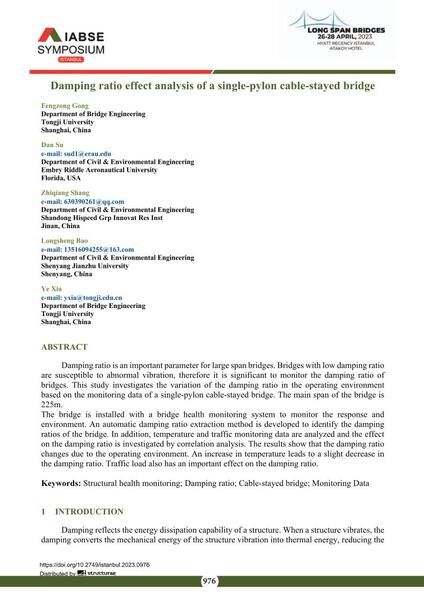Damping ratio effect analysis of a single-pylon cable-stayed bridge

|
|
|||||||||||
Détails bibliographiques
| Auteur(s): |
Fengzong Gong
(Department of Bridge Engineering Tongji University, Shanghai, China)
Dan Su (Department of Civil & Environmental Engineering Embry Riddle Aeronautical University, Florida, USA) Zhiqiang Shang (Department of Civil & Environmental Engineering Shandong Hispeed Grp Innovat Res Inst, Jinan, China) Longsheng Bao (Department of Civil & Environmental Engineering Shenyang Jianzhu University, Shenyang, China) Ye Xia (Department of Bridge Engineering Tongji University, Shanghai, China) |
||||
|---|---|---|---|---|---|
| Médium: | papier de conférence | ||||
| Langue(s): | anglais | ||||
| Conférence: | IABSE Symposium: Long Span Bridges, Istanbul, Turkey, 26-28 April 2023 | ||||
| Publié dans: | IABSE Symposium Istanbul 2023 | ||||
|
|||||
| Page(s): | 976-981 | ||||
| Nombre total de pages (du PDF): | 6 | ||||
| Année: | 2023 | ||||
| DOI: | 10.2749/istanbul.2023.0976 | ||||
| Abstrait: |
Damping ratio is an important parameter for large span bridges. Bridges with low damping ratio are susceptible to abnormal vibration, therefore it is significant to monitor the damping ratio of bridges. This study investigates the variation of the damping ratio in the operating environment based on the monitoring data of a single-pylon cable-stayed bridge. The main span of the bridge is 225m. The bridge is installed with a bridge health monitoring system to monitor the response and environment. An automatic damping ratio extraction method is developed to identify the damping ratios of the bridge. In addition, temperature and traffic monitoring data are analyzed and the effect on the damping ratio is investigated by correlation analysis. The results show that the damping ratio changes due to the operating environment. An increase in temperature leads to a slight decrease in the damping ratio. Traffic load also has an important effect on the damping ratio. |
||||
| Mots-clé: |
Pont à haubans
|
||||

